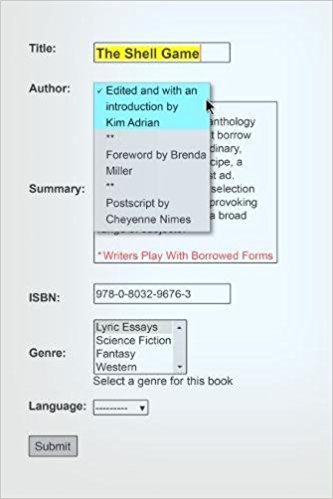Review by Donna Talarico
 It is best, when writing a book review of The Shell Game: Writers Play with Borrowed Forms, to be an active reader of the book.
It is best, when writing a book review of The Shell Game: Writers Play with Borrowed Forms, to be an active reader of the book.
So instead of lounging on your half of the sectional, as you’ll do when you first open The Shell Game, you’ll probably soon find yourself sitting upright so you can better mark pages and underline passages. You’ll probably do this most often during “Snakes & Ladders” by Anushka Jasraj because you’re a board game fanatic and will find some facts (and maybe recommended reading) you’ll want to remember.
Being an active participant in the book may also result in you oohing and ahhing and aha!’ing a few times, and you’ll be tempted to explain to your husband your expressions when he asks, from his side of the sectional: “What?” But stop yourself: you won’t want to get into conversation with someone; keep reading. You can make him encourage him to read the book to discover the same things on his own later. Stay engaged.
In a review of The Shell Game, you should provide a short appraisal of the strengths of the work.
For instance, you could share with them how you’ll need to take a breather after Dinty W. Moore’s alphabetized essay on fatherhood, “Son of Mr. Green Jeans” because it resonates so much with you. This will demonstrate that just because hermit crab essays allow you to have fun with form, they aren’t, when it comes to subject matter, always all play: these pieces can pack a punch as much as they can delight. For another example of this, you could send readers to Ingrid Jendrzjewski’s essay #miscarriage.exe, which is a haunting story nestled within code. PHP, you’ll learn, is a beautiful language. You might also want to compliment “As Is” by Brian Oliu, which you’ll find to be an incredibly moving essay told in the form of product specs. You’ll probably think about it after you move from the couch and into the bedroom and again as you try to sleep.
Depending on word count limits of you target publication, you could continue to offer examples of what you found compelling in your reading of The Shell Game.
You might want to mention how you marveled at the cover when you ripped open the padded envelope postmarked Lincoln, N.E. How it was, in itself, a clever shell for a book of, well, shells. You’ll probably want to point out that Brenda Miller’s foreword will reveal the origin of the term “hermit crab essay,” a nugget of information that all creative nonfiction writers will likely enjoy, even if they’re re-learning it. (And, because you’ll want them to experience the joy of discovery on their own, you should definitely not give this backstory in your review!!) Since you’ll certainly love Kim Adrian’s introduction—because you love nature guides and this intro is aptly told in the form of animal classification—you could share some of that insight through a quote. Such as her line, “The best essays of this type are usually conceived in a moment of bright insight. An explosion of possibility.”
(When that line reminds you of the hermit crab essay you’ve been working on for at least three years, long after your original moment of bright insight, you may consider including that tidbit in your review. Don’t. You should avoid the temptation to include your own stream of consciousness into a review. Just use the book as inspiration to finish what you started! But finish the book review first!)
In a review of The Shell Game, you also may provide a short appraisal of anything you didn’t like as much. (optional)
This would be the paragraph where you’ll mention that, while paging through the contributor bios, you become mildly annoyed when you notice one of the writers has a much higher word count than everyone else. But then you’ll suddenly realize this block of text isn’t something to critique at all: it’s actually meta and brilliant and you were so silly to be annoyed. So you’ll probably decide that this section of the book review is optional, that you most likely won’t see a weakness. (OK. Except that maybe nowhere on the book will say Vol. 1 or Book One—that is, the promise of a sequel—because you’ll probably want to see more hermit crabs in print after this.)
In a review of The Shell Game, do not try to cover everything in the book.
But you’ll probably want to. Especially the pieces you were most drawn to, like the ones that took on the form of a game (like Laurie Easter’s “Solving My Way to Grandma” or “The Six Answers on the Back of a Trivial Pursuit Card” by Caitlin Horrocks). This compilation, you’ll find, features essays from incredible writers, some whose work you’re familiar with and others you’ll meet for the first time in these pages. You’ll see an acknowledgements page that shows how many of these essays had already appeared elsewhere, showing how welcoming literary journals have been to the hermit crab essay. As a magazine editor, you’ll likely reflect on the essays you’ve published that have played with form, and suddenly crave more of them.
You’ll want to share an overview of each essay, but you shouldn’t. Instead, give readers something to look forward to.
Explain why you recommend The Shell Game.
Of course you’ll want to let essay fans know they’ll enjoy this book. But also be sure to let people know that, if they’re also a writer or if they teach writing, this collection can serve as a model. You’ve always been somewhat of a rebel, so you’ll want writers, especially those who stick to more rigid forms, to read this book to encourage them to have fun with their work. To take risks and chances.
Because there are 30 essays in this book, all so unique and surprising with each new story, you’ll come to decide that if you were to recommend this book to others, you’d likely tell them to savor it, make it last: that they should not read “binge-read” it, but rather treat themselves with a new form each day until they’ve read the last one.
A review of The Shell Game should include the publisher and price of the book at the end of the article. It may also include the year published and ISBN.
The Shell Game: Writers Play With Borrowed Forms (ISBN: 978-0-8032-9676-3) was published in 2018 by University of Nebraska Press, and the cover price is $24.95.
One or two of the book review instructions were modified from tutorials or guides found here:
- https://owl.english.purdue.edu/owl/resource/704/1/
- http://www.wendybelcher.com/writing-advice/how-to-write-book-review/
- https://rachellereacobb.com/how-to-write-a-book-review/

Donna Talarico
Founder, Publisher & Managing EditorDonna Talarico is the founder of Hippocampus Magazine and Books and its conference, HippoCamp. Her creative nonfiction appears in The Superstition Review, The Los Angeles Review, The Los Angeles Times, The New York Times (Modern Love’s Tiny Love Stories), Wanderlust Journal, and The Writing Disorder (from which her essay “A Prequel to My Sister’s” was nominated for a Pushcart Prize in 2022).
While running Hippocampus is a full-time effort in itself, it’s a volunteer position; her *actual* job is as an independent writer and content strategist in higher education. Donna has more than two decades of experience in marketing, communications, writing and media, and about half of that time has been in higher education. She speaks at higher education and publishing conferences, writes an adult learner recruiting column for Wiley, and has contributed to Guardian Higher Education Network, The Writer, mental_floss, Games World of Puzzles, and others.
Donna teaches or has taught about branding and digital identity in several graduate creative writing programs, including Wilkes University and Rosemont College, as well as at Pennsylvania College of Art & Design. She earned an MFA in creative writing from Wilkes University in Wilkes-Barre, Pa. (2010), and, later, she returned to Wilkes to pursue a master’s in literary publishing (2016). She also has an MBA from Elizabethtown College and a bachelor’s degree in communication studies from Wilkes.
She lives Lancaster, Pa. with her husband, Kevin Beerman and their cat. She loves road trips, national parks, board games, greasy-spoon diner breakfasts, and museums.


